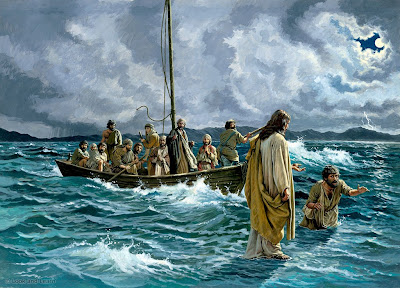
I've just come across an interesting addition to the 'Look & Learn' website. Click here to go to their new 'Animations' section then select the '3D fly-throughs' option.
By far the best is the second one, which is titled "Christ walking on the Sea of Galilee' and based on the picture above. All these animations are done from flat original 'Look & Learn' artwork which presumably is then digitally separated into levels. I've been wanting to try something like this with our Bible pictures, except I would like to take it a step further by combining this technique with our 3D Bible pictures! That would give you a fly-through animatic that you could watch with 3D glasses! Wow!
Because our Bible pictures are already in separate digital layers, in theory, it should be relatively easy to do! Shouldn't it?
Look & Learn offer this '3D fly-through' technique on most of the pictures in their vast picture library. All the superb pictures in their library are also available for commercial licensing.
Picture © Look & Learn Magazine Ltd 2008
Related links:
Look & Learn
The Bible Story
9 comments:
This looks great Graham. It pulls you into the scene. If you can figure this out it'll definitely help add a new dimension to your illustrations.
I think a fly-through 3-D illustration could be a good source for headaches Graham. It should come with a bottle of aspirin. LOL
I also think it's pointless as the separation of layers you see in the Look & Learn illustration creates its own 3-D effect. It's used in TV documentaries quite often to add depth to photographs or even comic strips.
I think that you might be right Paul.
I was thinking about this afterwards. The other problem is that the 3D conversion can drain the color out of the illustration. The combination of effects could also make it look like you are moving through flat 3D cutouts! I will reserve judgement though until I see it done. It might be amazing!
The application of this technique would have to be thought out also. It could be good for a children's Bible story video.
Sorry, I should have said DVD-!!
Showing my age!
I think less is more in this instance Graham. If you overuse the technique it detracts from the message. But it is a good way of getting children interested if used sensibly.
But as you say, you have to find a way to avoid the flat cut-out effect. It can look like cardboard figures placed on a stage. Varying the focus of attention to create a good depth of field between the figures and background is essential. Something the Look & Learn technique doesn't allow for.
Graham, I don't know much about your technical terms, but I like the color. Thank you for sharing, smile. Deboraw
This looks like the kind of thing that broadcast designers do. I get to see this sort of work fairly often, as that major works in the same building that we animators do.
I can try and find out more info on how this technique works, if you'd like.
As far as the 3-D illustrations go, I remember reading an article quite a while where they mentioned a few tips on how to avoid causing headaches and nausea with 3-D. I found it here, about halfway down: http://features.cgsociety.org/story_custom.php?story_id=4352.
Thanks for that Jumbo.
I've been chatting with the chap in the states who did the above 'fly-through'.
He also produces 'Lenticular' cards. They are the plastic coated pictures that you often find in boxes of breakfast cereal. The image changes when you tilt the card from side to side. They have a slightly ribbed surface that everyone likes to run their finger nail down!
Lenticular cards are getting pretty sophisticated nowadays. I did a search of 'Lenticular cards' and was amazed at some of the images that they can do now, including film clips!
I think that the technique used is similar to the one used on our 3D conversions.
Hi
Great blog nice information provide by you Props from the movie sets can come from a variety of sources. Often, after a film's premiere, the studio will auction off many of the props and costumes used in the film for the purpose of charity.
Post a Comment